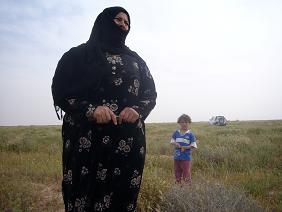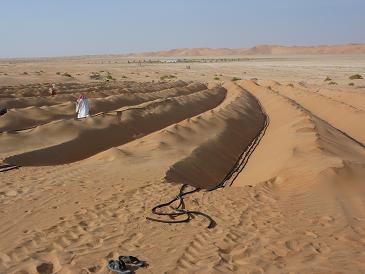Adapting agriculture to climate change: a ‘no-regrets’ option for development and environment
Feeding a global population of just over 9 billion by 2050 will put huge pressure on our planet’s scarce natural resources, even without climate change. The world’s 500 million smallholder farms already provide the bulk of the food eaten in developing countries but will need to play an even greater role. Appropriate and innovative finance is needed for the poorest communities to build their resilience to climate change.

Climate change follows no monthly calendar. But with its hard-hitting storms, increasing droughts and severe floods damaging farmlands in developing countries, it is demonstrating its inexorable progression, and putting 500 million smallholder farms at increasing risk.
The international community, governments and private sector share an important responsibility to finance and support climate resilient agriculture.
We have many proven measures to support them but success will depend on how effectively we empower smallholders to manage their assets, of which the natural resource base is perhaps the most important, and diversify their farm and off-farm businesses. Public sector investment in sustainable agricultural practices and technologies must be coupled with improved access to markets, microfinance and a range of other services for rural communities. This will make it possible for smallholders to invest in their assets and knowledge, unleashing their potential to be agents of adaptation.
Smallholders bear the brunt of climate impacts
Rural communities are particularly vulnerable to climate change given their direct reliance on weather-dependant natural resources, their often limited access to institutions and markets, and their resulting reduced capacity to cope with a range of shocks such as food price spikes or extreme weather events. By damaging the asset base of smallholder and subsistence farmers, degrading their soils, water sources, forest, sea and river products, climate change reduces their incomes and their chance to thrive. Adaptation for them is not optional but an increasing, daily challenge.
Today, smallholder farmer households represent half of the world’s undernourished people, three-quarters of Africa’s malnourished children, and the majority of people living in absolute poverty and in marginal ecosystems. Globally, smallholder families constitute the vast majority of the poor, living on less than US$2 a day. Climate change has reduced the likelihood of achieving the first of the Millennium Development Goals to halve the prevalence of hunger by 2015, with Sub-Saharan Africa likely to be the most food insecure region. In ten years’ time, between 75 and 250 million more people in Africa alone are expected to be exposed to water and food security stress – the majority of them rural and smallholder farmers.
Growth in agricultural productivity will need to almost double every year to avoid encroaching into already stressed ecosystems and make up for the impacts of climate change (World Development Report 2010). Smallholder farmers are too big a group covering too large a land area to be ignored, under the assumption that increasingly industrial agricultural production will render them non-players. Rather, we should recognise them as a cost-effective investment for increasing yields and intensifying agriculture in ways that reduce poverty, maintain and build on the natural resource base and enhance climate resilience.
Do more, better: an ecosystems approach
If the agricultural systems that smallholders manage are to be productive and sustainable, they need clean water and healthy soil, and a variety of genetic resources and ecological processes. A healthy ecosystem can foster productivity and diversify income-generating activities, for instance through apiculture, the harvesting of indigenous medicinal plants or ecotourism. The international community has come to clarity on the point that healthy ecosystems underpin sustainable development.
However, the Fourth Assessment Report of the Intergovernmental Panel on Climate Change in 2007 warned us that the resilience of many ecosystems to changes in climate could be surpassed within our lifetimes. This represents a huge threat for agriculture. For temperature increases exceeding 1.5 – 2.5° C, about 20-30 per cent of plant and animal species will be at increased risk of extinction and major changes in the ecosystem are predicted in the medium and long term.
Even in the near future, agriculture will take place under significantly changed environmental conditions. For developing countries, particularly Africa, it will require producing more under less favourable conditions, such as changing or shorter traditional growing seasons, less predictable rainfall patterns, and with fewer or less robust ecosystem services. In all cases, it will require dealing with more uncertainties. In a few decades, the world could see more food insecurity and hunger crises, more conflicts over scarce natural resources, and more displacement and migration. If we don’t approach climate-resilient agriculture now, any gains we make will be compromised.
As the custodians of natural resources, smallholders’ engagement in ecosystem-based adaptation is key in promoting sustainable agriculture programmes.The involvement ofgrassroots organisations, community groups, women and young people in planning and managing the natural resources that sustain agriculture is essential for an ecosystems approach.
IFAD in Al-Badia, Syria
In the arid Syrian steppe zone or Al-Badia, IFAD is working with local communities to reduce herders’ vulnerability to climate change and restore the long-term productivity of rangelands. After years of severe drought and intensive grazing, rangelands in Al-Badia were severely degraded.
By reintroducing native plants that help meetfodder requirements, fixing the soil and stopping sand encroachment, ecosystems have been restored and the local population’s vulnerability to the effects of climatic instability reduced.
After two years of resting, reseeding and planting, birds, insects and animals returned to the area contributing to ecosystem restoration. The rehabilitated ecosystems offer further potential for income generation as truffles grow in some areas of Al-Badia. In 2010, a community with a 100,000 hectare grazing area could earn up to US$1 million from truffle collecting.
Leaving the ‘trade-off’ mentality behind
Once we understand that making agriculture climate resilient is also about protecting and enhancing ecosystem services, we come to an important conclusion: the choice between reducing poverty, adapting to climate change, feeding the world or protecting the environment is a false one. What we need, in the words of Professor Swaminathan, is an ‘evergreen’ revolution powered by sustainable agriculture that balances inputs with crop needs so that surplus inputs are avoided and soil fertility and the ecosystem are not compromised, and 21st century technology that will simultaneously achieve all of these objectives and include smallholder farmers.
The challenge that we now face is to scale up the right sustainable practices in the right places, and to ensure that smallholder farmers can adopt them and benefit from them.
Start by scaling up the ‘no-regrets’ actions
There is a range of proven agricultural practices and technologies ready to be deployed at scale to limit the negative effects of climate change and provide substantive development gains. Balanced-input agriculture, for example, makes the most efficient use of seeds and fertiliser, land and water, energy and labour. Great strides are being made to bring cropland, rangeland and woodland under sustainable land management (SLM) approaches that are grounded in community empowerment, including land tenure rights, and efficient use of natural resources. Conservation agriculture techniques are also showing real promise for scalable methods of production and ‘green’ approaches in land use and preservation.
Technologies ready for scale up include tolerant/resistant crop varieties based on drought or heat, salt, insects or pests, and improved seeds, all of which provide potential for increasing yields and improving the resilience of livelihoods across regions.
Agro-forestry and other integrated agricultural approaches provide improved vehicles for dealing with complexity and change – and we have seen them make a difference on the ground through better irrigation, fisheries management and infrastructure that achieve development and poverty reduction objectives and build climate resilience.
We are ready to do more of all of this, at scale.
Support new technologies for long-term challenges
In the face of long-term climate challenges, we know that today’s knowledge and technologies won’t be enough. IFAD therefore supports promising technologies that are new to the market but still require promotion and piloting.
In development jargon, they are more ‘knowledge-intensive’ - which means that farmers need training in how and why to use them and incentives to adopt them, while governments need support in formulating policies that provide those incentives either directly or through markets.
Dutyion test site in the UAE
One example of a promising new technology is the Root Hydration System owned by DuPont. Faced with increasing climate-induced water stress, the government of Jordan, in collaboration with IFAD, the Global Environment Facility, DuPont and local farming communities, is testing this innovative andlow-energy irrigation technology.
The innovation is a new, durable plastic tubing material that retains contaminants while letting clean water through the pipe’s surface to the plants’ roots. This new system will allow farmers to use saltwater and low-grade, brackish water to irrigate their crops.
It has great potential to increase the land available for cultivation, enabling smallholder farmers to grow more crops in water-stressed zones, particularly in coastal areas, without competing for precious freshwater supplies.
Value traditional knowledge to strengthen resilience
New technology is important but one weakness of the first Green Revolution was that it overlooked the value of traditional knowledge and the seed varieties held by farmers. Promoting, revitalising and scaling up existing local and traditional knowledge on crop management and ecosystem services can effectively support adaptation to climate change by marginal rural and indigenous communities and strengthen the deployment of new technologies.
IFAD is supporting indigenous communities through programmes such as the Regional Programme in Support of Indigenous Peoples of the Amazon Basin (PRAIA). The programme aims to recapture the traditional knowledge of indigenous groups that helps them diversify their incomes and food sources, for example, in the harvesting of indigenous plant species for food in times of drought and medicine in times of hardship.
IFAD in the Philippines

In the Philippines, the IFAD-supported Cordillera Highland Agricultural Resource Management Project has replicated the ‘Lapat’ indigenous system to protect the country’s vast watersheds. This traditional system calls upon all community members and neighbouring communities to observe rules for environmental protection. These include restrictions on cutting trees, gathering rattan, hunting animals, and even fishing in the rivers and streams within the ‘Lapat’ area.
By promoting adoption of the ‘Lapat’ system, national and regional authorities have empowered indigenous communities to take over the responsibility, care and management of forests and natural resources. By the end of 2007, some 50,000 households were practicing the ‘Lapat’ system. The sustainability of this approach lies in the blending and linking of indigenous practices within modern institutional and policy frameworks. In this case, ancestral land was surveyed and over 1,000 land ownership certificates were issued, strengthening the indigenous communities’ vested, long-term interest in their land.
Practical research to benefit smallholders
Climate adaptation requires the blending of local knowledge with scientific research. IFAD has a history of supporting and interacting with research institutes and other technical bodies, including the CGIAR, to test, adapt and disseminate technologies.
IFAD has taken a lead in mobilising interest in and donor support for research on some of the most important crops of poor people, such as plantain, bamboo and rattan, and cassava.Cassava research has been supported for over two decades, with a range of products generated, including improved cassava varieties, highly cost-effective biological control technology for two major cassava pests, transfer of improved cassava varieties from Latin America to Africa and, together with CGIAR, FAO and others, the development of a global cassava development strategy, with significant impacts for rural poor people.
Beyond carbon markets: Payments for ecosystem services
Given the apparent difficulties in securing access for smallholders to carbon market revenues, we must look more closely at other payments for ecosystem services (PES) approaches to provide smallholder farmers with increased revenue streams or incentives and foster an integrated and sustainable approach to agriculture.
PES, if formulated correctly, has significant potential to bolster rural livelihoods and agricultural yields, and maintain and enhance ecosystem services, such as watersheds and biodiversity. In addition it can contribute to disaster risk reduction, with PES revenues generated serving as financial buffers for communities to climate-induced shocks. Provided with financing opportunities and incentives, smallholders and rural communities can invest in preventing natural disasters by maintaining sand dunes, mangrove belts, coral reefs, wetlands and forested slopes as cost-effective measures, while at the same time protecting their own assets and livelihoods. Dependable revenue streams would allow them to invest in their crops and land, strengthening their businesses.
RUPES project in Asia
A promising pilot called ‘Reward Upland Poor of Asia for the Environment Services they Provide’ (RUPES), implemented in China, Indonesia, Laos, Nepal, the Philippines and Vietnam through the World  Agroforestry Centre, has shown great potential for PES. In Indonesia alone, over 6,000 farmers in 18 communities received permits to grow coffee while protecting the forests. Providing communities with clear land tenure rights gave them the incentive to maintain or restore environmental services, such as replanting and managing forest areas.
Agroforestry Centre, has shown great potential for PES. In Indonesia alone, over 6,000 farmers in 18 communities received permits to grow coffee while protecting the forests. Providing communities with clear land tenure rights gave them the incentive to maintain or restore environmental services, such as replanting and managing forest areas.
One community negotiated with a private dam operator to reduce silt in the river by applying soil protection techniques on their plots in return for a micro-hydroelectric machine for energy supply. The company then engaged in negotiations with communities upstream of other dams. These activities also benefit lowland communities by protecting the watersheds, and shore up carbon sinks. In addition to a scaled up RUPES-II project, a follow-up programme, Pro-poor Rewards for Environmental Services in Africa (PRESA)is currently being piloted in Guinea, Kenya, Tanzania and Uganda. These activities are providing further evidence that PES incentives don’t necessarily need to be financial, but can be provided in the form of secure land rights.
Increase smallholder profits through sustainable value chains
There is often a misconception that sustainable approaches to agriculture are not profitable or that smallholders are not viable business partners at scale. The experience base that IFAD has built with partner governments and smallholder communities demonstrates the contrary. The private sector does have an appetite for working with smallholders when they are sufficiently organised. Public-private partnerships can help to identify where smallholders’ comparative advantages lie and connect more of them to business opportunities, increasing their profits.
In Sao Tome and Principe, IFAD linked cocoa farmers with KAOKA, a French organic chocolate-maker that agreed to purchase as much organic cocoa as farmers could supply. The programme halted the planned razing of existing cocoa plantations, maintained their productive capacity, avoided a potential increase in pesticide use and considerably improved the incomes of participating farmers from 25 per cent below the poverty line to eight per cent above it. This is just one example of linking smallholder farmers to sustainable value chains.
In today’s globalised world, international markets coexist with traditional markets characterised by smallholder-dominated, low-input production systems. Environmental or eco-friendly value chains can provide good opportunities for smallholders because of the value they place on certain low-input production methods. Value chains also offer an opportunity to promote and support sustainable agriculture practices.
IFAD is working with smallholders and other partners in Albania, Cameroon, Fiji, Guatemala, India, Laos, Morocco, Zambia and elsewhere to get their sustainably produced fish fingerlings (young fish), french beans, onions, coconuts, turmeric, olives, almonds and meat to larger markets. Farmers, fishermen, herders and governments all understand that profits lie in access to markets, and agricultural value chains can provide that access. Given the opportunity and incentive to link to them, farmers will organise and cooperate to compete. Support will help them strengthen their comparative advantage and remain competitive in an increasingly globalised and volatile international agricultural market.
Smallholders are ready
The imperative of reducing emissions globally to stave off climate change is clear but we must ensure that climate and other innovative finance reaches the poorest communities to build their resilience to climate change. The World Bank-led Economics of Adaptation to Climate Change study estimates it will cost US$70 – 100 billion each year to adapt to climate change between now and 2050. Unfortunately, additional financial support for adaptation to date has been woefully inadequate.
Smallholder farmers account for 60 per cent of global agriculture and provide 80 per cent of food in developing countries (Cosgrove and Rijsberman 2000). Their households alone account for one-third of the world’s population, and constitute the largest share of the developing world’s undernourished (FAO). We must embark on a rapid programme of action to increase sustainable agriculture that rewards ‘no regrets’, multiple-benefit investments and includes smallholders. Many of these approaches are already available. It’s time for the public sector to prioritise these and give the market signals the private sector is looking for.











